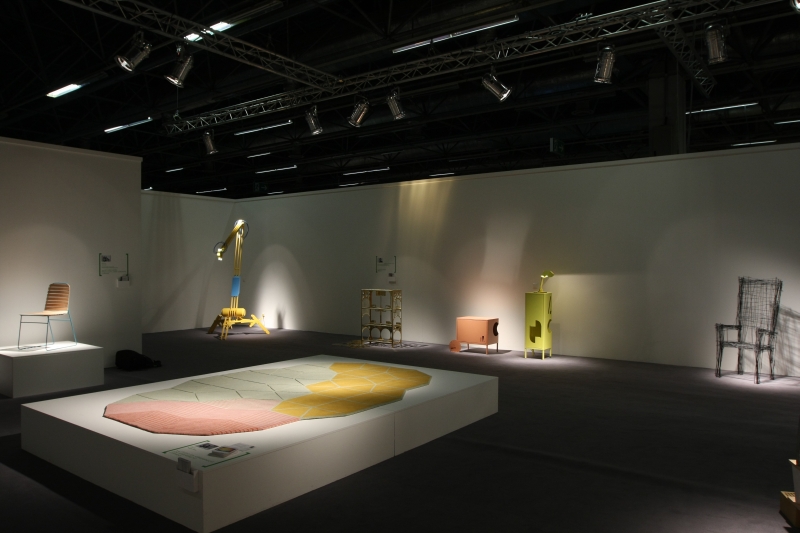Curated annually by the German Design Council on behalf of Cologne Trade Fair the [D3] Contest is an international competition for young designers that reaches its conclusion every January with an exhibition and awards ceremony at IMM. The 2014 edition attracted over 600 entries, 22 of which made it onto the short list and so into the Cologne exhibition.
And while we retain our well-founded distrust of design competitions, we do know that the [D3] Contest exhibition is a regular haunt of those manufacturers who inhabit halls 2, 3 and 11. And indeed one or the other manufacturer who themselves aren’t represented at IMM Cologne. No names, no pack-drill, but during IMM Cologne 2014 we saw numerous familiar faces moving, anonymously, over the stand. Consequently we do give [D3] a little more credence that most design competitions.
Aside from 2014 [D3] Contest winner, Ordnungshalber by Christoph Goechnahts, the 2014 [D3] exhibition contained several interesting and noteworthy projects including the carpet Isla by Berlin based Joa Herrenknecht, the project “Combination Parasite Production” by Samuel Treindl, a project that also featured in the exhibition “Objects and the Factory” and which was awarded an Appreciation in the Cradle-to-Cradle category at the International Marianne Brandt Contest 2013, and, and while not wanting to give the impression that we’re blowing our own trumpet, Granoff Sofa by Taylor McKenzie-Veal, a project we posted after having seen it at Milan 2013 where it was presented as part of the Rhode Island School of Design (RISD) exhibition in the middle of Ventura Lambrate. So on a stand with other projects in a hall full of projects in a district full of projects.
We believe we were the only people who felt suitably moved upon seeing it in Milan to write about it.
Ta ta ta taaa
Now we’re by no means claiming that the inclusion of Granoff Sofa in the [D3] Contest is a guarantee of the project’s excellence – God alone know we’ve seen some abominations in the show over the years – nor does it imply we were or are in any way correct, for that we’ve been wrong far too often. But it does give an indication that we understand at least something about our responsibilities and duty to yourself dear reader.
In contrast that is to those of our colleagues who recently published such gushing, fulsome tributes to another finalist in the 2014 [D3] Contest, the Drawing Series by Korean designer Jin Il Park.
We’ve now seen Drawing Series, or at least the chair from the series. It’s a decent enough project. But nowhere near as good as one could expect from the texts that appeared the other week. And is certainly not worth the column inches it got.
It doesn’t look like a line drawing. It looks like it has been inspired by a line drawing. It doesn’t look like a two dimensional sketch. It looks like it has been inspired by a two dimensional sketch. It looks very much like a three dimensional chair.
A perfectly competent three dimensional chair. But not much else.
The problem of course isn’t Jin Il Park’s project but rather the near complete dependence of internet based design platforms on perfectly composed, perfectly illuminated, invariably post-processed photos supplied by designers/manufacturers. Photos which are consumed unquestioned by the editorial team before being regurgitated as the foundation for justifying the projects right to exist.
One shouldn’t comment on a piece of furniture design, industrial design or product design that you personally have never seen.
You wouldn’t write a restaurant review without eating in the restaurant, would you?
A book review without reading the book?
An album review without hearing the album?
But because everyone thinks “design” is related to fashion – photos are OK.
They’re not.
And then people wonder that design is reduced to “style”; that being given the option to choose the colour of your trainers or shape of spoiler on your car means your “designing” your possessions. You’re not. Your being told you are by a marketing department looking to increase market share over their competitors.
Part of the problem with the public’s misguided perception of design is unquestionably down to leading designers accepting well paid projects that have nothing to do with design, but the biggest problem is online design portals writing about projects based on a press release and a few perfectly photo-shopped press photos. And because that’s how the popular design media understand design, no-one should be surprised that then is then how the public understand design.
And that has to stop.
Anyone who claims to be publishing anything about design should, neigh must, get out there and look at projects, test projects, understand projects ….. then form an opinion.
Otherwise, be honest enough to alter the “design” in your platform to “style”
Or start writing about fashion!
Sorry, but ya know….
A few impressions from the [D3] Contest 2014 exhibition:
